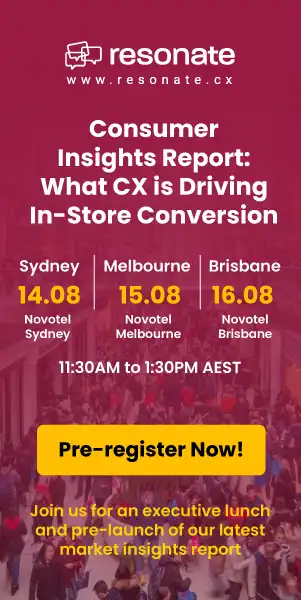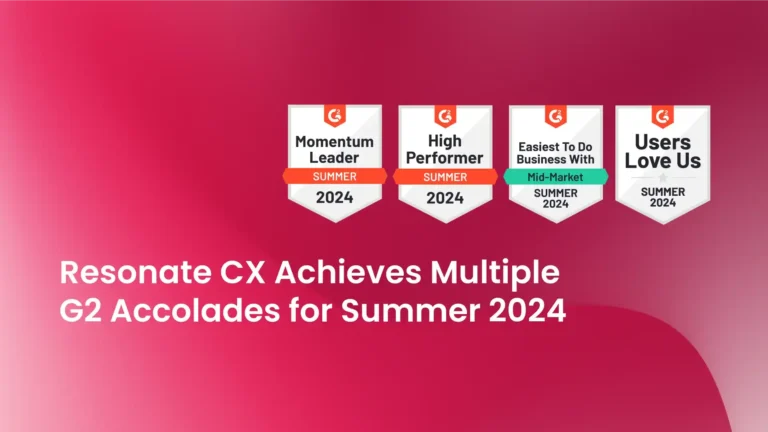Take a look at this review below:
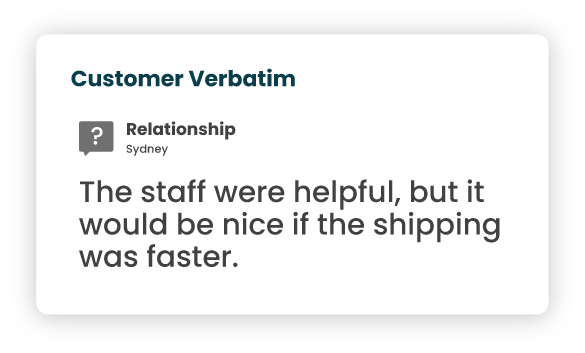
Seems easy enough to decipher that the customer was pleased with the staff but wished they received the product faster, right?
But what if your business received hundreds upon thousands of reviews, each requiring equal attention?
Doesn’t seem too easy, does it?
What if there was a method that could swiftly sift through and make sense of the valuable information buried in massive piles of text?
Text analytics offers a solution, enabling the processing of large quantities of unstructured text data quickly —within minutes, not weeks. It extracts sentiments, topics, and themes from customer feedback and organizes them into an easy-to-understand module that sorts positive, neutral, and negative responses.
In this blog post, we’ll talk about all this and more to help you make sense of customer feedback with speed and accuracy through text analytics. Let’s dive in!
What is Text Analytics?
Text Analytics Definition
Text analytics, often referred to as text mining, involves pulling out crucial details from textual data. In the context of Customer Experience Management, this could include data from survey responses, emails, support tickets, speech-to-text conversions, and any other forms of feedback that are provided in free text.
Text analytics enable you to navigate through text more efficiently and capture essential information that might have been overlooked.
Why is Text Analytics Important?
Like most businesses conducting feedback from its customers, you are also probably sitting on a wealth of information that can guide your strategic choices. From the calls you have with customer service and the buzz on social media, to all those emails and feedback from surveys.
Through text analytics, you can efficiently mine valuable insights from various feedback channels. This automated process guarantees both uniformity and dependability in the analysis.
Text analytics tools help you spot trends, discern patterns, and understand the critical points from your data, arming you with the insights required for well-informed decision-making. For example, you can quickly identify negative feedback in surveys, enabling proactive measures to address customer issues and safeguard your company’s brand image.
Two of the most commonly used techniques in text analytics are:
- Sentiment analysis: This technique involves identifying and categorizing the emotional tone behind a piece of text. By determining whether the sentiment is positive, negative, or neutral, you can gain a better understanding of how your customers feel about your products, services, or brand. Sentiment analysis helps you identify areas for improvement, monitor customer satisfaction, and respond to feedback in a timely manner.
- Topic and theme categorization: This approach sorts text data into specific categories or themes, simplifying the identification of commonly discussed topics. By organizing related topics, you can easily keep track of popular subjects. This technique is instrumental in keeping track of emerging trends, grasping customer preferences, and aligning efforts with the most critical customer issues or opportunities.
Basic vs. Advanced Text Analytics
Now that you understand why text analytics is important in the business sense, let’s discuss briefly the two categories of text analytics to help you understand its applications better.
These two categories are basic and advanced. Basic text analytics involves simple techniques like keyword extraction and sentiment analysis. On the other hand, advanced text analytics leverages more sophisticated techniques like topic modeling, named entity recognition, and semantic analysis to uncover deeper insights and contextual meaning.
Text Analytics Applications
Text analytics has a wide range of applications across various industries. Some common use cases include:
By extracting insights from this text data, companies can identify common issues, sentiment trends, and areas for improvement in their products or services. This helps them make data-driven decisions to enhance the overall customer experience.
Text analytics techniques are applied to monitor and analyze social media conversations related to a brand, product, or topic.
This can be in the form of analyzing news articles, blog posts, reviews, and social media conversations to identify potential reputational risks, track sentiment changes, and measure the effectiveness of their PR efforts.
Text analytics is also used to analyze customer feedback collected through various channels, such as surveys, emails, chat logs, and call center transcripts. By applying sentiment analysis, topic modeling, and keyword extraction techniques to gain a deeper understanding of customer needs, preferences, and pain points.
Text analytics is utilized to monitor and analyze information related to competitors. By processing news articles, press releases, reviews, and social media conversations, companies can gain insights into their competitors’ strategies, product offerings, customer perceptions, and market positioning.
Text Analytics Example
To illustrate the power of text analytics like in the use cases above, let’s look at this example:
A smartphone company leverages text analytics to monitor feedback about their products. They identify trending topics and customer sentiment, allowing them to adapt their marketing strategies and product offerings accordingly.
As a result, text analytics reveals major themes around ‘battery life’, ‘camera functionality’, and ‘user interface’. Advanced sentiment analysis showed nuanced concerns, such as appreciation for the camera’s capabilities in daylight but dissatisfaction with low light performance.
Battery life complaints were often linked with charging time issues.
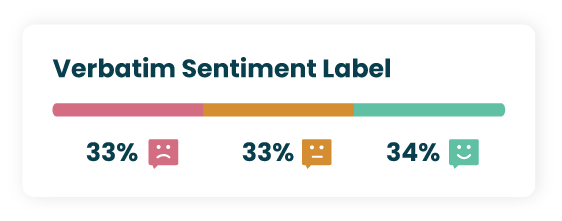
Overall, text analytics helped identify specific features causing discontent, leading to targeted recommendations for product improvement.
Resonate.CX Text Analytics
Now that you have a clearer grasp of what text analytics is and how it can benefit your company, you probably get why it’s important for your customer experience management (CXM) platform to have an advanced tool like text analytics in its arsenal.
The Resonate CX platform’s Text Analytics module offers a powerful suite of tools designed to transform overwhelming volumes of unstructured customer feedback into clear-cut insights, as follows:
Sentiment Score of Verbatim
The sentiment score of verbatim indicates the sentiment levels from positive, neutral, to negative.
Topics and Themes
Topics help monitor areas you wish to focus on. These are fixed categories where customer verbatims are bucketed into. Meanwhile, themes reflect emerging and prevalent customer sentiments and are composed of keywords or themes mentioned in the verbatims. [insert benefits here]
Here’s are examples of the two:
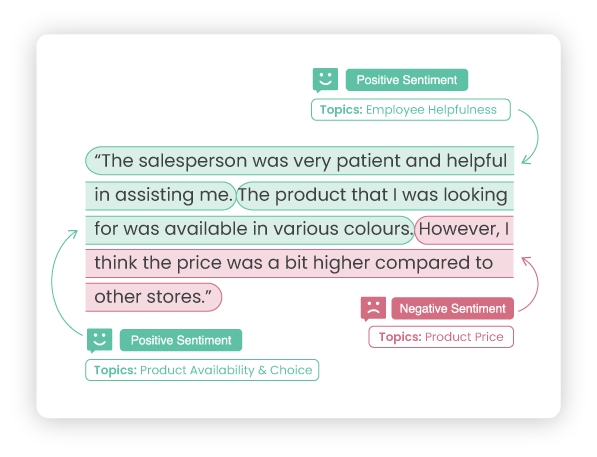
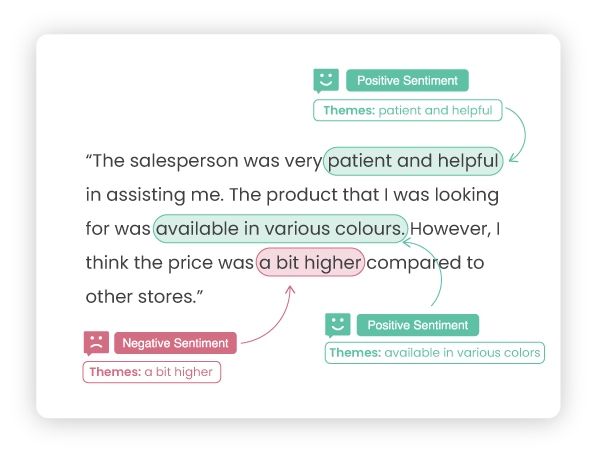
Browsing, Discovering, and Analyzing Customer Sentiments
Resonate.CX’s Text Analytics allows you to browse and see the overall sentiment and identify the percentage of positive, neutral, and negative sentiments. You can also keep track of sentiment trends over time and see distribution of volume throughout the period.
Resonate.CX’s Text Analytics module also allows you to discover customer-specific concerns and wins through “Topics” or responses by topic sentiment. We measure the frequency of each topic and sentiment split by percentage with ordering based on volume, prioritizing topics by their prevalence.
Likewise, we display the top 50 most mentioned keywords and provide you with a clear view of customer feedback focus areas.
Through the Customer Verbatim Tile, you can analyze feedback with ease.
Identifying Smoke Detectors
The Resonate.CX dashboard is dedicated to highlighting trending topics, providing users with immediate insights into what is most pertinent at any given time. You can also order customer sentiments by their sentiment score, creating a customer sentiment leaderboard that highlights areas of customer satisfaction or concern.
Lastly, the Resonate CX Platform uses text analytics to reveal trends and patterns in customer feedback over time through sentiment over day of week feature wherein sentiments are aggregated and displayed per day of the week.
Conclusion
The applications of text analytics are vast and varied, touching every aspect of customer experience management. From identifying product improvement opportunities to monitoring brand reputation, text analytics offers a granular view of what customers love, what they tolerate, and what they despise. It allows businesses to prioritize efforts, focus on areas of concern, and enhance what they do best, ensuring that customer satisfaction remains at the heart of their operations.
The Resonate.CX platform exemplifies the pinnacle of what text analytics can achieve, offering businesses a comprehensive suite of tools to delve deep into customer feedback. By providing insights into sentiment scores, trending topics, and emerging themes, Resonate.CX enables companies to stay ahead of the curve, ensuring they are not just responsive but proactive in addressing customer needs and preferences.
In conclusion, as we journey through the digital age, text analytics stands as an indispensable ally for businesses seeking to forge deeper connections with their customers. It transforms the overwhelming into the manageable, the obscure into the clear, guiding businesses towards informed decision-making and strategic planning. With tools like Resonate.CX, the path to enhanced customer experience and business growth is not just illuminated but paved with the insights garnered from the very voices of those we seek to serve.
Looking to incorporate Text Analytics in your customer experience journey? Request a quick demo today!
